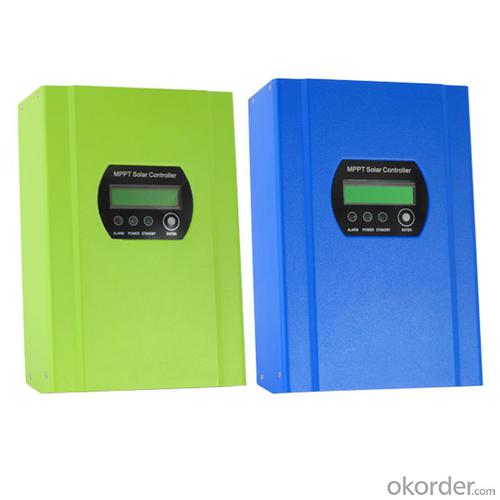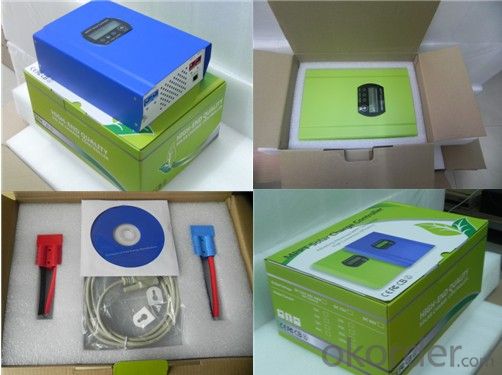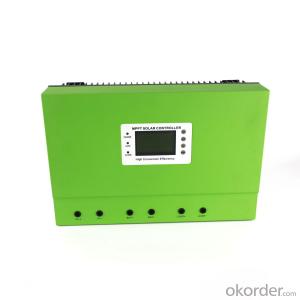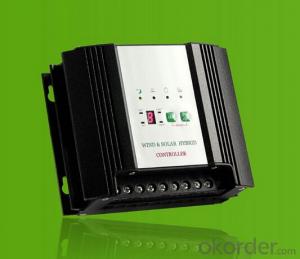German Solar Controllers Multifunctional 30A 96V Battery MPPT Solar Charge Controller 20A~30A
- Loading Port:
- China main port
- Payment Terms:
- TT OR LC
- Min Order Qty:
- 20 unit
- Supply Capability:
- 9999 unit/month
OKorder Service Pledge
OKorder Financial Service
You Might Also Like
96V Auto identification MPPT Solar Charge Regulator 30A with LCD and LED
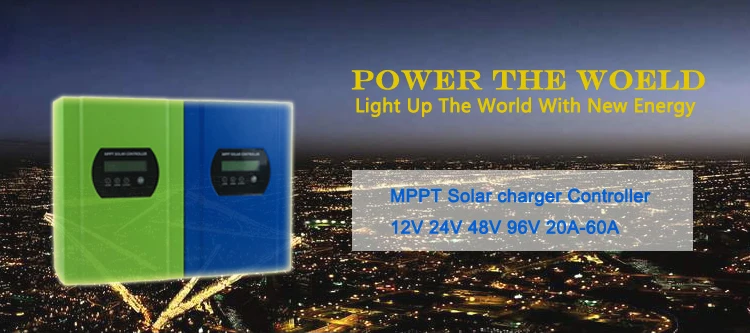
| Introduction |
This is a smart solar charge controller which has advanced MPPT technology .
Solar charge controller is one of the important parts in the off-grid solar system.
For having the advanced MPPT technology, the controller can trace the peak power with 99%
conversion efficiency. MPPT microprocessor, inside the controller,making 30% more charge
current with significantly less power than tradition. In addition to this, easier installing and supporting
to expand volume are other advantages. It can also store energy to different kinds of batteries.
We provide battery choice(Vented,Sealed,Gel,NiCd).
| Product Show |
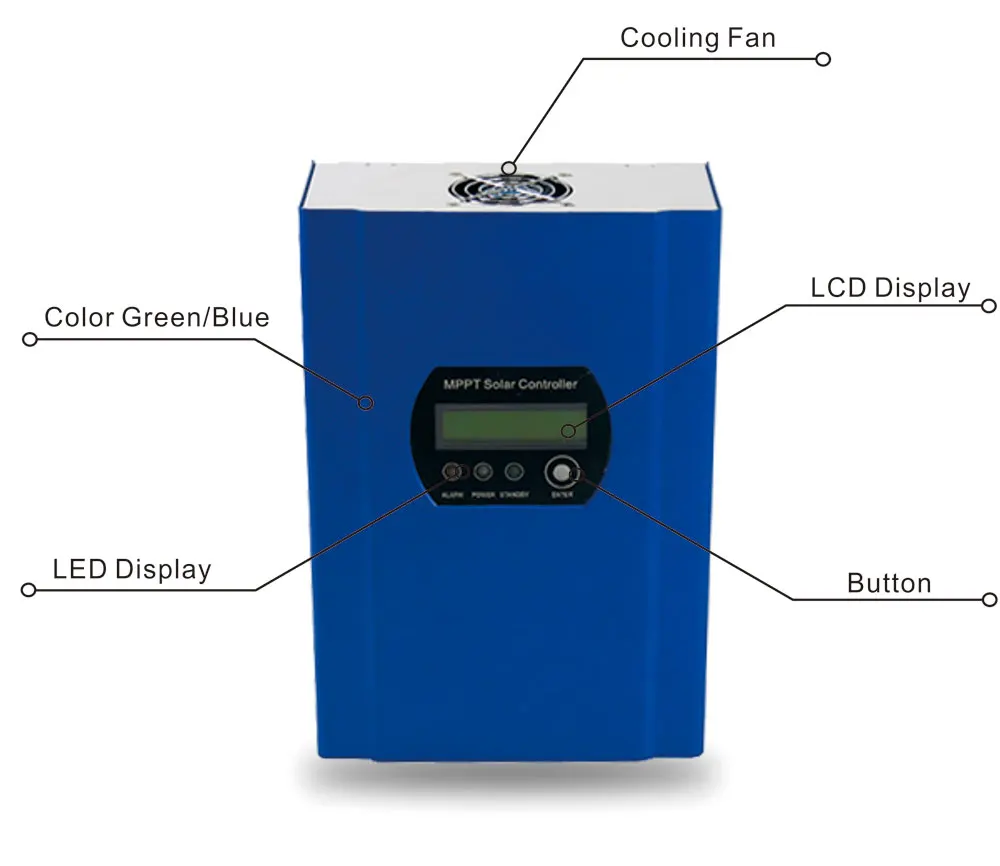
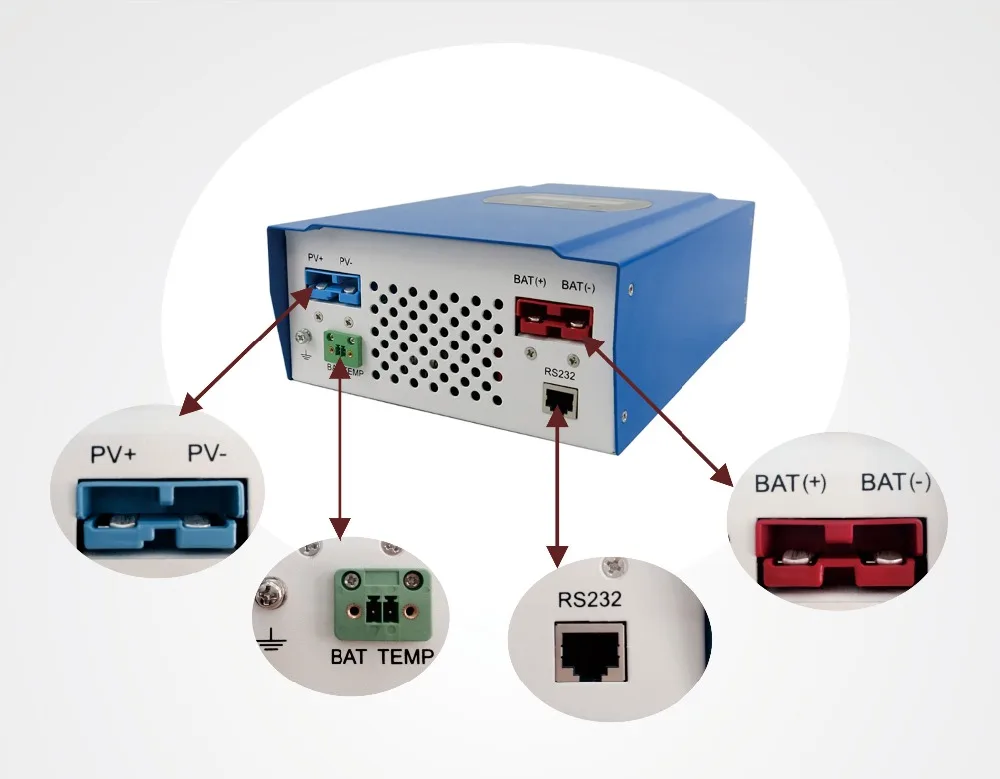
Please check the design brief,technical documents,product manual etc .
| Features |
1. Peak efficiency upto 99% with MPPT,increasing 30%~60% efficiency than traditional controller.
2. 12v/24v/48v system voltage automatic recognize.
3. Maximum input PV voltage upto DC150V.
4. 105degrees can be sufferred by good components.
5. Charge mode: three stages (fast charge, constant charge, floating charge)
6. Support kinds of batteries:Gel,Sealed lead acid,vented,NiCd,etc.
7. LCD and LEDs show parameters and system information,like PV input voltage,battery voltage,charge current,charge power,etc.
8. Port RS232 or connects to PC with upper software to show working state and parameters in 11 languages.
9. CE,RoHS certificatons approved.
10. 2 years warranty;3~10 years extended technical service.
| Application |
Off grid PV system show with our I-P-TPI Pure sine wave inverter:

| Parameter |
Model: I-P-MSC-DC12V/24V/48V/96V-series | 20A | 30A | ||
Charge Mode | Maximum Power Point Tracking | |||
Method | 3 stages: fast charge(MPPT),constant voltage,floating charge | |||
System Type | DC12V/24V/48V/96V | Automatic recognition | ||
System Voltage | 12V system | DC9V~DC15V | ||
24V system | DC18V~DC30V | |||
48Vsystem | DC36V~DC60V | |||
96Vsystem | DC72V~DC120V | |||
Soft Start Time | 12V/24V/48V/96V | ≤10S | ||
Dynamic Response Recovery Time | 12V/24V/48V/96V | 500us | ||
Conversion Efficiency | 12V/24V/48V/96V | ≥96.5%,≤99% | ||
PV Modules Utilization Rate | 12V/24V/48V/96V | ≥99% | ||
Input Characteristics | ||||
MPPT Working Voltage and Range | 12V system | DC18V~DC150V | ||
24V system | DC34~DC150V | |||
48V system | DC65~DC150V | |||
96Vsystem | DC125~DC300V | |||
Low Voltage Input Protection Point | 12V system | DC16V | ||
24V system | DC30V | |||
48V system | DC60V | |||
96Vsystem | DC120V | |||
Low Voltage Input Recovery Point | 12V system | DC22V | ||
24V system | DC34V | |||
48V system | DC65V | |||
96Vsystem | DC125V | |||
Max DC Voltage | 12V/24V/48V system | DC160V | ||
96Vsystem | DC300V | |||
Input Overvoltage Protection Point | 12V/24V/48V system | DC150 | ||
96Vsystem | DC300V | |||
Input Overvoltage Recovery Point | 12V/24V/48V system | DC145V | ||
96Vsystem | DC295V | |||
Max. PV Power | 12V system | 280W | 450W | |
24V system | 560W | 850W | ||
48V system | 1120W | 1700W | ||
96Vsystem | 2240W | 3400W | ||
Output Characteristics | ||||
Selectable Battery Types (Default type is GEL battery) | 12V/24V/48V/96Vsystem | Sealed lead acid, vented, Gel, NiCd battery | ||
Constant Voltage | 12V/24V/48V/96Vsystem | Please check the charge voltage according to the battery type form. | ||
Floating Charge Voltage | 12V/24V/48V/96Vsystem | |||
Over Charge Protection Voltage | 12V system | 14.6V | ||
24V system | 29.2V | |||
48V system | 58.4V | |||
96V system | 116.8V | |||
Rated Output Current | 12V/24V/48V/96Vsystem | 20A | 30A | |
Current-limiting Protection | 12V/24V/48V/96Vsystem | 25A | 35A | |
Temperature Factor | 12V/24V/48V/96Vsystem | ±0.02%/℃ | ||
Temperature Compensation | 12V/24V/48V/96Vsystem | 14.2V-(The highest temperature-25℃)*0.3 | ||
Output Ripples(peak) | 12V/24V/48V/96Vsystem | 200mV | ||
Output Voltage Stability Precision | 12V/24V/48V/96Vsystem | ≤±1.5% | ||
The specification is only for reference. Subject to change without prior notice.
RS232 Function working stat |
The Figures of the PC Firmware and Testing Software:
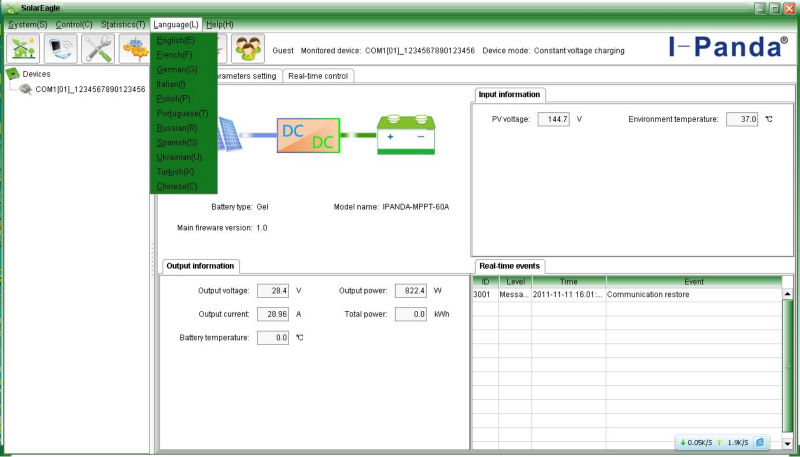

We provide OEM and ODM service.The 36V/72V/96V model also can be custom made for you.
Packaging |
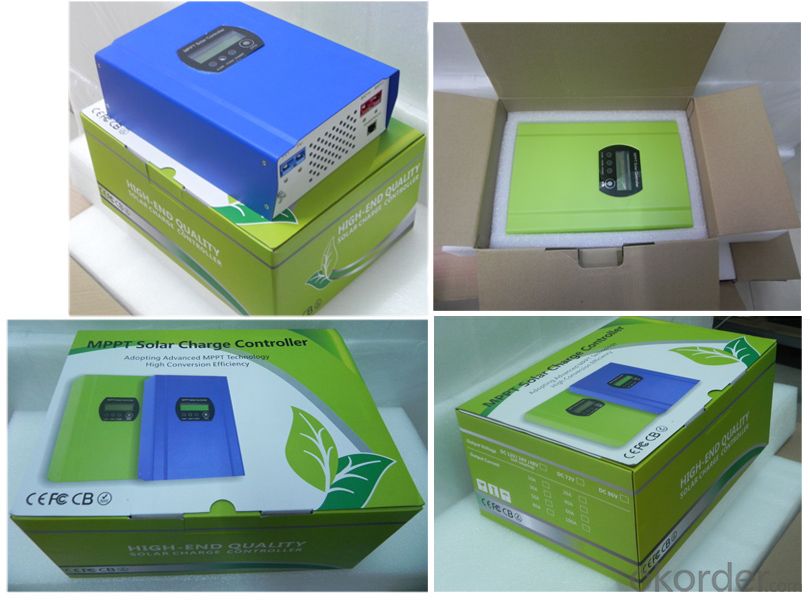
Certifications |
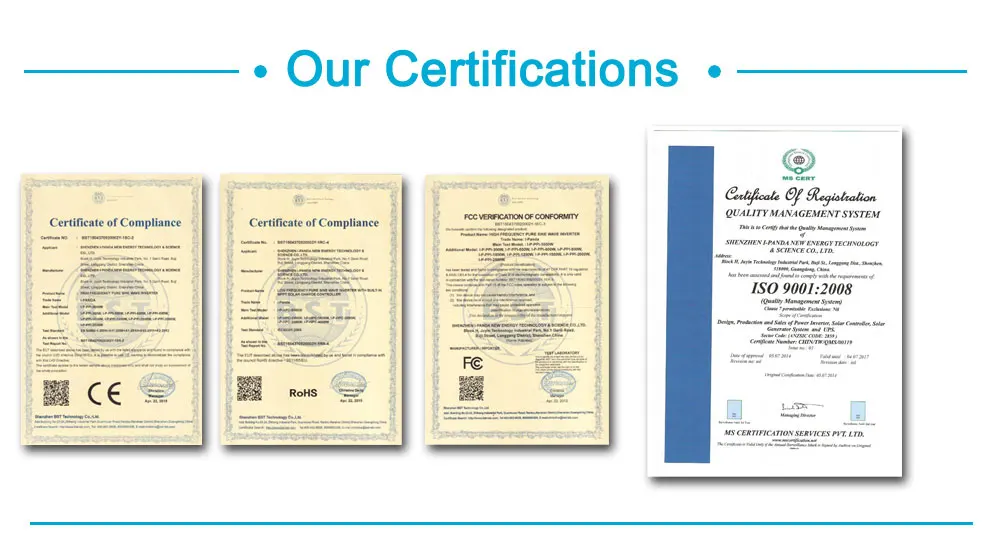
F&Q: |
Q1. How to ensure and monitor the products quality?
A1: We have established a perfect Quality Management System, In strict
accordance with ISO9001: 2008 quality system and ISO14001 environment system for quality assurance management;
Our ISO9001:2008 Quality System certificate encoding: CHIN/TW/QMS/00119;
Our ISO14001 Environment System certificate encoding: CHIN/TW/EMS/00028;
Q2. What is the warranty of products?
A2: The warranty period of different products are different; 5 years, 3 years, 2 years, 1 years; More details please refer to the product specification or manual; we will provide free life-long technical support ;
Q3. What is the difference between MPPT&PWM?
A3. MPPT charging mode, peak efficiency up to 99%, saving 30%~60% solar panel than traditional PWM controller.
- Q: Can a solar controller be used with a solar-powered charging station for mobile devices?
- Yes, a solar controller can be used with a solar-powered charging station for mobile devices. The solar controller helps regulate the voltage and current from the solar panels, ensuring efficient and safe charging of the devices connected to the charging station.
- Q: What is the size and weight of a typical solar controller?
- The size and weight of a typical solar controller can vary depending on the specific model and brand. However, most solar controllers are relatively compact and lightweight. They are typically small enough to fit in the palm of your hand and can weigh anywhere from a few ounces to a few pounds.
- Q: Can a solar controller be used with solar-powered smart city infrastructure?
- Solar-powered smart city infrastructure can indeed utilize a solar controller. This device, also referred to as a charge controller or regulator, plays a crucial role in a solar power system. Its primary function involves regulating the voltage and current from the solar panels to effectively charge the batteries and prevent overcharging. When it comes to solar-powered smart city infrastructure such as streetlights, traffic signals, or surveillance systems, a solar controller becomes even more essential. It plays a pivotal role in managing the energy generated by the solar panels, ensuring proper storage in the batteries and releasing it as required to power the smart city devices. Moreover, a solar controller offers additional functionalities that prove advantageous for smart city infrastructure. Advanced models, for instance, come equipped with built-in communication capabilities, enabling them to connect to a central monitoring system. This facilitates real-time monitoring of the solar power system's performance, encompassing battery voltage, charging status, and other vital parameters. Such data plays a critical role in maintaining and optimizing the operation of smart city infrastructure. To conclude, a solar controller not only harmonizes with solar-powered smart city infrastructure but also serves as a vital component in guaranteeing efficient energy management and optimal performance of the entire system.
- Q: Can a solar controller be used with solar panels of different brands?
- Yes, a solar controller can be used with solar panels of different brands as long as the voltage and current ratings of the panels are compatible with the controller. The controller's main function is to regulate the charging process and protect the batteries, regardless of the brand of the solar panels being used.
- Q: How do I troubleshoot common issues with a solar controller?
- To troubleshoot common issues with a solar controller, start by checking the connections between the solar panels, battery, and load to ensure they are secure and properly connected. Verify that the solar panels are receiving adequate sunlight and that the battery has sufficient charge. Next, inspect the controller for any visible damage or loose wires. If everything appears to be in order, reset the controller by disconnecting it from the power source and reconnecting it after a few minutes. If the problem persists, consult the controller's user manual or contact the manufacturer for further assistance.
- Q: Can a solar controller be used with solar-powered indoor cultural facilities?
- Solar-powered indoor cultural facilities can indeed utilize a solar controller. The purpose of a solar controller is to regulate the charging and discharging of batteries within a solar power system. Traditionally, solar power has been associated with outdoor applications such as residential or commercial buildings. However, it can also be effectively employed in indoor cultural facilities such as museums, art galleries, libraries, or exhibition halls that prioritize sustainability and environmental friendliness. Implementing a solar controller in these facilities offers several advantages. Firstly, it ensures that the solar panels efficiently convert sunlight into electricity and effectively charge the batteries. By controlling the energy flow, it prevents overcharging, which can potentially harm the batteries. As a result, a reliable and consistent power supply is guaranteed for the indoor cultural facility. Furthermore, a solar controller aids in monitoring the energy consumption of the facility. It provides real-time data on solar power generation, battery status, and overall energy usage. This valuable information enables facility managers to optimize energy consumption, identify any potential issues, and make well-informed decisions to enhance energy efficiency. Moreover, solar controllers often come equipped with built-in features like load control and timers. This allows facility managers to exercise control over the utilization of solar power within the indoor cultural facility. For instance, lights or climate control systems can be programmed to operate during specific hours or only when necessary. This approach minimizes energy wastage and maximizes the utilization of solar power. In conclusion, there is no doubt that a solar controller can be effectively employed in solar-powered indoor cultural facilities. It facilitates efficient energy conversion, enables energy consumption monitoring, and empowers control over solar power usage. By embracing the use of a solar controller, indoor cultural facilities can become more sustainable, reduce their environmental impact, and simultaneously maintain a reliable power supply.
- Q: Can a solar controller be used with solar-powered gate openers?
- Yes, a solar controller can be used with solar-powered gate openers. A solar controller is responsible for regulating the flow of electricity from the solar panels to the gate opener's battery, ensuring optimal charging and preventing overcharging. It helps maximize the efficiency and lifespan of the gate opener's battery by maintaining the correct voltage and current levels.
- Q: How do I clean and maintain a solar controller?
- To clean and maintain a solar controller, start by turning off the power and disconnecting any external power sources. Use a soft cloth or brush to remove any dust or debris from the surface of the controller. If there are stubborn stains, mix a mild soap solution with water and gently wipe the affected areas. Avoid using abrasive cleaners or solvents. After cleaning, ensure that all connections are secure and free from any corrosion. Regularly check for any loose wires or damaged parts, and replace them if necessary. Finally, keep the solar controller in a dry and well-ventilated area to prevent moisture buildup.
- Q: Can a solar controller handle power surges from the grid?
- No, a solar controller is not designed to handle power surges from the grid. Its primary function is to regulate and control the flow of power from the solar panels to the battery or load, and it does not have the capability to protect against or manage power surges coming from the grid. For that purpose, additional surge protection devices or equipment would be required.
- Q: What is the role of a solar controller in preventing battery undercharging?
- Ensuring the longevity and optimal performance of solar battery systems relies heavily on the crucial role played by a solar controller in preventing battery undercharging. Acting as a mediator between the solar panels and batteries, the solar controller effectively regulates the energy flow and safeguards against undercharging. When electricity is generated by solar panels, it is initially in the form of direct current (DC) and must be converted and controlled before being stored in the batteries. This task is effectively carried out by a solar controller, which continuously monitors the voltage and current levels of both the solar panels and batteries. Among the primary functions of a solar controller is the prevention of battery overcharging, which can cause damage or reduce the batteries' lifespan. However, it is equally important in averting battery undercharging. Undercharging occurs when the batteries do not receive enough charge to reach their full capacity, resulting in diminished performance and a shortened lifespan. To address this issue, the solar controller consistently monitors the battery voltage and adjusts the charging current accordingly. It ensures that the batteries receive an adequate amount of charge to replenish any energy consumed, thereby maintaining them at an optimal state of charge. The solar controller employs a charge algorithm that takes various factors into account, including battery type, ambient temperature, and charging conditions, to determine the appropriate charging current. By adjusting the charging voltage to align with the battery manufacturer's specifications, the solar controller effectively prevents both overcharging and undercharging. Furthermore, solar controllers often incorporate additional features such as temperature compensation and low voltage disconnect (LVD) to further safeguard against battery undercharging. Temperature compensation adjusts the charging voltage based on the ambient temperature, ensuring optimal charging regardless of weather conditions. LVD protects the batteries by disconnecting loads when the voltage falls below a specific threshold, thus preventing excessive discharge and undercharging. In summary, the role of a solar controller in preventing battery undercharging revolves around regulating the energy flow from solar panels to batteries, constantly monitoring voltage and current levels to guarantee a sufficient charge. By preventing undercharging, the solar controller maximizes the performance, lifespan, and overall efficiency of solar battery systems.
Send your message to us
German Solar Controllers Multifunctional 30A 96V Battery MPPT Solar Charge Controller 20A~30A
- Loading Port:
- China main port
- Payment Terms:
- TT OR LC
- Min Order Qty:
- 20 unit
- Supply Capability:
- 9999 unit/month
OKorder Service Pledge
OKorder Financial Service
Similar products
Hot products
Hot Searches
Related keywords




